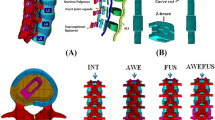Abstract
Background
Little evidence is available addressing biomechanical properties of posterior distraction forces and their effects on anterior spinal column in the growing rod technique. The question is often asked if posterior distraction forces may be kyphogenic. The goal of this study is to determine whether posterior distraction forces transmitted anteriorly through different foundation constructs (i.e., screws vs. hooks) affect intradiscal pressure.
Methods
Six skeletally immature porcine spines were harvested leaving soft tissues and rib heads intact. Pedicle screws served as the lower foundation on a L3–L4 motion segment while pedicle screws and laminar hooks were randomly used at T3–T4 levels. Proximal constructs (hook vs. screw) were switched after initial distraction testing. The dual rod distractor was instrumented with strain gauges and calibrated using a custom force transducer. During distraction, intradiscal pressures immediately inferior to the superior foundation and the level equidistant between foundations were measured using needle pressure transducers. Maximum distraction force and maximum anterior disc pressure change were compared between hook and pedicle screw anchors using one-way ANOVA (p < 0.05).
Results
Upper foundations with pedicle screws had significantly greater distraction forces (416 ± 101 N) than those with upper level hooks (349 ± 100 N). There were no significant differences in disc pressures between levels or between upper foundation constructs. Disc pressures adjacent to the upper foundation demonstrated greater reduction (disc expansion) than the level equidistant within the construct. Pedicle screw constructs demonstrated greater endplate separation (distraction) compared to hook constructs.
Conclusions
Posterior distraction forces result in anterior disc separation (distraction) and are distributed across multiple levels rather than delivered to the disc immediately adjacent to a foundation. Constructs with upper foundation hooks had lower distraction forces possibly due to hook motion during distraction. The load distribution at multiple levels may assist with curve control and may affect vertebral growth. The distraction forces may not be kyphogenic as is commonly believed.




Similar content being viewed by others
References
Kennedy JD, Robertson CF, Olinsky A, Dickens DR, Phelan PD. Pulmonary restrictive effect of bracing in mild idiopathic scoliosis. Thorax. 1987;42:959–61.
Kose N, Campbell RM. Congenital scoliosis. Med Sci Monit. 2004;10:RA104–10.
Campbell RM, Smith MD Jr, Mayes TC, Mangos JA, Willey-Courand DB, Kose N, Pinero RF, Alder ME, Duong HL, Surber JL. The characteristics of thoracic insufficiency syndrome associated with fused ribs and congenital scoliosis. J Bone Jt Surg Am. 2003;85-A:399–408.
Emery JL, Mithal A. The number of alveoli in the terminal respiratory unit of man during late intrauterine life and childhood. Arch Dis Child. 1960;35:544–7.
Harrington PR. Treatment of scoliosis. Correction and internal fixation. Bone Jt Surg Am. 1962;44-A:591–610.
Moe JH, Kharrat K, Winter RB, Cummine JL. Harrington instrumentation without fusion plus external orthotic support for the treatment of difficult curvature problems in young children. Clin Orthop Relat Res. 1984;185:35–45.
Mineiro J, Weinstein SL. Subcutaneous rodding for progressive spinal curvatures: early results. J Pediatr Orthop. 2002;3:290–5.
Thompson GH, Akbarnia BA, Kostial P, Poe-Kochert C, Armstrong DG, Roh J, Lowe R, Asher MA, Marks DS. Comparison of single and dual growing rod techniques followed through definitive surgery: a preliminary study. Spine. 2005;18:2039–44.
Akbarnia BA, Marks D. Instrumentation with limited arthrodesis for the treatment of progressive early-onset scoliosis. Spine State Art Rev. 2000;14:181–9.
Akbarnia BA, Marks DS, Boachie-Adjei O, Thompson AG, Asher MA. Dual growing rod technique for the treatment of progressive early-onset scoliosis: a multicenter study. Spine. 2005;30:S46–57.
Akbarnia BA, McCarthy R. Pediatric Isola instrumentation without fusion for the treatment of progressive early onset scoliosis. In: McCarthy R, editor. Spinal instrumentation techniques. Chicago: Scoliosis Research Society; 1998.
Asher M. Isola spinal instrumentation system for scoliosis. In: Bridwell K, editor. Textbook of spinal surgery. Philadelphia: Lippincott-Raven; 1997. p. 569–609.
Mahar AT, Bagheri R, Oka R, Kostial P, Akbarnia BA. Biomechanical comparison of different anchors (foundations) for the pediatric dual growing rod technique. Spine J. 2008;8:933–9.
Cil A, Yazici M, Daglioglu K, Aydingoz U, Alanay A, Acaroglu RE, Gulsen M, Surat A. The effect of pedicle screw placement with or without application of compression across the neurocentral cartilage on the morphology of the spinal canal and pedicle in immature pigs. Spine. 2005;30:1287–93.
Yazici M, Pekmezci M, Cil A, Alanay A, Acaroglu E, Oner FC. The effect of pedicle expansion on pedicle morphology and biomechanical stability in the immature porcine spine. Spine. 2006;31:E826–9.
Luque ER. Paralytic scoliosis in growing children. Clin Orthop Relat Res. 1982;163:202–9.
Willers U, Transfeldt EE, Hedlund R. The segmental effect of Cotrel–Dubousset instrumentation on vertebral rotation, rib hump and the thoracic cage in idiopathic scoliosis. Eur Spine J. 1996;5:387–93.
Klemme WR, Denis F, Winter RB, Lonstein JW, Koop SE. Spinal instrumentation without fusion for progressive scoliosis in young children. J Pediatr Orthop. 1997;17:734–42.
Skaggs DL. Classification of treatment of early onset scoliosis. Presented at 2nd international congress on early onset scoliosis and growing spine (ICEOS), November 7–8, 2008, Montreal, QC.
Smit TH. The use of a quadruped as an in vivo model for the study of the spine—biomechanical considerations. Eur Spine J. 2002;11:137–44.
Acknowledgments
None of the authors received financial support related to the execution or publication of this manuscript. Institutional/Lab support was provided by Depuy Spine directly to the Institution.
Author information
Authors and Affiliations
Corresponding author
About this article
Cite this article
Mahar, A., Kabirian, N., Akbarnia, B.A. et al. Effects of posterior distraction forces on anterior column intradiscal pressure in the dual growing rod technique. J Orthop Sci 20, 12–16 (2015). https://doi.org/10.1007/s00776-014-0646-8
Received:
Accepted:
Published:
Issue Date:
DOI: https://doi.org/10.1007/s00776-014-0646-8




